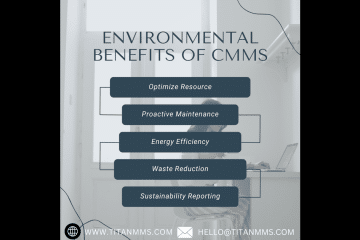Introduction
In today’s fast-paced business environment, maintaining operational efficiency is crucial. One tool that has proven invaluable in achieving this is a Computerized Maintenance Management System (CMMS). This article will explore the myriad benefits of implementing a CMMS and the return on investment (ROI) it offers.
Importance of CMMS in Maintenance Management
The role of a CMMS in maintenance management cannot be overstated. It significantly aids in preventive maintenance, ensuring that equipment is serviced regularly, thus avoiding unexpected breakdowns. Additionally, CMMS helps in asset tracking, providing detailed information about each asset’s history and current status.
Key Benefits of Implementing CMMS
Implementing a CMMS offers numerous benefits, from boosting productivity to enhancing equipment lifespan. Let’s delve into these advantages in detail.
Improved Productivity
One of the primary benefits of CMMS is improved productivity. By streamlining workflows and automating scheduling, CMMS ensures that maintenance tasks are carried out efficiently. This reduces the time spent on manual processes, allowing maintenance teams to focus on more critical tasks.
Streamlined Workflows:
CMMS provides a centralized platform for managing all maintenance activities. This streamlines workflows by eliminating the need for multiple disparate systems and reducing the chances of errors.
Automated Scheduling:
Automated scheduling is another significant advantage. CMMS allows for the automatic scheduling of maintenance tasks based on predefined criteria, ensuring that all necessary maintenance is performed on time.
Enhanced Equipment Lifespan
Regular maintenance is key to extending the lifespan of equipment. CMMS plays a critical role in this by sending regular maintenance alerts and helping manage assets more effectively.
Regular Maintenance Alerts:
CMMS can automatically send alerts for scheduled maintenance activities, ensuring that no maintenance task is overlooked. This regular upkeep helps in prolonging the equipment’s lifespan.
Better Asset Management:
With CMMS, all asset-related information is stored in one place, making it easier to manage and monitor assets. This comprehensive asset management ensures that equipment is maintained in optimal condition.
Reduced Downtime
Downtime can be costly for any business. CMMS helps in minimizing downtime by enabling quick issue resolution and providing real-time monitoring of equipment.
Quick Issue Resolution:
When issues arise, CMMS facilitates quick resolution by providing immediate access to relevant information and resources. This reduces the time taken to diagnose and fix problems.
Real-Time Monitoring:
Real-time monitoring allows for the continuous tracking of equipment status. CMMS can alert maintenance teams to potential issues before they lead to significant downtime, ensuring smooth operations.
Cost Savings
Implementing a CMMS can lead to substantial cost savings. By reducing repair costs and lowering energy consumption, CMMS proves to be a cost-effective solution.
Reduced Repair Costs:
Preventive maintenance reduces the likelihood of major repairs, resulting in lower repair costs. CMMS ensures that maintenance is performed regularly, thus preventing costly breakdowns.
Lower Energy Consumption:
Efficiently maintained equipment operates more efficiently, consuming less energy. CMMS helps in maintaining equipment in optimal condition, leading to lower energy bills.
Better Compliance and Safety
CMMS aids in achieving better compliance with regulatory standards and enhances workplace safety by enforcing safety protocols.
Regulatory Compliance:
CMMS helps in maintaining records of all maintenance activities, ensuring compliance with industry regulations. This is particularly crucial for industries with stringent regulatory requirements.
Safety Protocols:
By ensuring regular maintenance, CMMS minimizes the risk of equipment failure, which can lead to safety hazards. It also helps in implementing and monitoring safety protocols.
Data-Driven Decision Making
A significant advantage of CMMS is its ability to provide detailed analytics, facilitating data-driven decision-making. It also supports predictive maintenance, anticipating issues before they occur.
Detailed Analytics:
CMMS collects and analyzes data on various maintenance activities, providing insights that help in optimizing maintenance processes and improving efficiency.
Predictive Maintenance:
Predictive maintenance uses data analytics to predict when equipment is likely to fail, allowing for proactive maintenance. CMMS supports this by providing the necessary data and tools.
Scalability and Flexibility
CMMS systems are scalable and flexible, capable of adapting to the growth of a business and offering customizable features to meet specific needs.
Adapting to Business Growth:
As businesses grow, their maintenance needs evolve. CMMS systems can scale accordingly, ensuring that maintenance processes remain efficient regardless of the business size.
Customizable Features:
CMMS solutions often come with customizable features, allowing businesses to tailor the system to their specific requirements. This flexibility ensures that CMMS can meet diverse business needs.
ROI of Implementing CMMS
The ROI of implementing a CMMS is significant. While there is an initial investment, the long-term gains far outweigh the costs. Businesses often see improvements in productivity, cost savings, and equipment lifespan.
Initial Investment vs. Long-Term Gains:
Although the initial investment in a CMMS can be substantial, the long-term benefits, such as reduced downtime and maintenance costs, provide a compelling ROI.
Case Studies and Real-World Examples:
Numerous case studies highlight the positive impact of CMMS on various businesses. These real-world examples demonstrate the substantial ROI that CMMS implementation can deliver.
Challenges in Implementing CMMS
Despite its many benefits, implementing a CMMS can present challenges, such as initial setup costs and the need for employee training.
Initial Setup Costs:
The initial setup costs for CMMS can be high, covering software purchase, installation, and integration with existing systems.
Employee Training:
To fully leverage the benefits of CMMS, employees need to be trained on how to use the system effectively. This requires time and resources.
Overcoming Implementation Challenges
Businesses can overcome these challenges by investing in effective training programs and choosing the right CMMS vendor.
Effective Training Programs:
Comprehensive training programs ensure that employees are well-versed in using CMMS, maximizing the system’s benefits.
Choosing the Right CMMS Vendor:
Selecting a reliable CMMS vendor is crucial. A good vendor provides support during implementation and offers ongoing assistance to ensure the system’s success.
Conclusion
In conclusion, the benefits and ROI of implementing a CMMS are substantial. From improved productivity and cost savings to enhanced equipment lifespan and better compliance, CMMS proves to be a valuable asset for any business. Despite the challenges in implementation, the long-term gains make it a worthwhile investment.
FAQs
Q1. What industries benefit most from CMMS?
Ans. Industries such as manufacturing, healthcare, and facilities management benefit significantly from CMMS due to their high maintenance needs.
Q2. How long does it take to see ROI from CMMS?
Ans. ROI can typically be seen within the first year of implementation, although this can vary depending on the size and complexity of the organization.
Q3. Can CMMS integrate with other business systems?
Ans. Yes, most CMMS solutions can integrate with other business systems such as ERP and accounting software, providing a seamless flow of information.
Q4. What are the key features to look for in a CMMS?
Ans. Key features include work order management, asset tracking, preventive maintenance scheduling, and real-time monitoring.
Q5. Is CMMS suitable for small businesses?
Ans. Absolutely. CMMS can be scaled to fit the needs of small businesses, providing the same benefits of improved efficiency and cost savings.




0 Comments